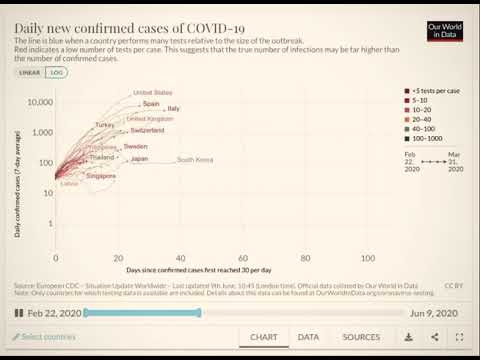9 by 9: Their Pandit is not our Pandit
Who are the Columbia J-school grads who can afford to spend Rs 10 lakh a month?
1 by 9: The worm is rising
Life’s scary enough as it is, but these graphics of how Coronavirus has progressed from February 22 to June 9, culled from the excellent work done by Mark C. Roser of Our World in Data, show the direction in which India is headed as it unlocks.
Compared to Germany, Italy and Spain, a public health physician says India has still not peaked in the number of new infections.


2x9: Their Pandit is not our Pandit
The killing of sarpanch Ajay Bharti Pandita in his orchard by terrorists in Anantnag in south Kashmir, is all the more remarkable for this video in which he complains of the lack of security.


The assassination of the Congress sarpanch has been met with silence from the BJP-ruled NDA government at the Centre, but for a token statement.
The journalist Rahul Pandita who chronicled the plight of Pandits in Our Moon Has Blood Clots points out how the community is caught between the two parties.


3 by 9: Floyd and Faizan
Brut connects the plight of the minorities in the United States and India, and contrasts the public empathy, police action and accountability in the two counties.


4 by 9: The long-necked swan lake
India and China are sparring over Pangong Tso, a lake perched 14,270 feet above sea level and stretching over 134 km, in the upper reaches of Ladakh. But how does it look, without the men in uniform and their jeeps and ammunition?
On Instagram, the writer Sheila Kumar has a set of three exquisite pictures.

“While no fish swim in these saline waters on the Indian side, the lake and its immediate vicinity are regularly visited by bar-headed geese, Brahminy ducks, kiang and marmots.
“Sixty per cent of Pangong Tso flows in the Tibetan Autonomous Region, the remaining forty per cent in India. Wherein lies the rub? Well, the LAC actually passes through the lake,” she writes.
5 by 9: Because +84 comes before +91
For all the talk of India benefitting from companies fleeing China after COVID, Sunil Jain of Financial Express, says a Nomura study shows that of the 56 firms that have left China, 26 have shifted base to Vietnam—only 3 of them have come to India.
So far.
Jain says Vietnam has benefitted from a free trade agreement with Europe, while India is still twiddling its thumbs after walking out of the 15-member regional comprehensive economic partnership (RCEP), in November 2019.


But this should surprise nobody.
Vietnam was slated to be the bigger winner from the US-China trade war as indicated by US president Donald Trump a year ago
Thousands have lost jobs since the virus broke. Tarun Shukla, the aviation editor of The Economic Times, has tweeted a termination letter sent out by Emirates.
6 by 9: Aati kya Khandala?
While the geyser that is north India is heating up, it’s already raining in the South.
Railway bureaucrat Anant Rupanagudi has just the frame for sore eyes: Pranit Wagdhare’s picture of a train sliding along India’s wettest route, the creation of the “Metro Man” E. Sreedharan and his team at Konkan Railway Corporation.


7 by 9: Case of flying paranthas
Restaurants are finally open, and there are partitions between guests, but how are they sending the stuff to you from the kitchen?
BBC cartoonist Kirthish Bhatt pries into the dining hall.
In Bangalore’s tiny Vidyarthi Bhavan in Gandhi Bazaar, where you can barely place two plates on a table, the partition tickles Thejaswi Udupa.


8 by 9: Data is the new oil
Nearly half the number of students who join the Graduate School of Journalism at Columbia University in New York every year are from Asia but who are those loaded enough to get in?
Tim Herera of The New York Times says the average cost of a 12-month program for a master's degree in data journalism at Columbia Journalism School will cost you $159,206, i.e. Rs 1,20,26,986.

Veena Venugopal writes: Considering the number of Columbia grads applying for entry-level journalism jobs in India, this is especially shocking. It’ll take two lifetimes to pay this off (yes, yes, I know, MumDad took care of this for most)
9 by 9: How blue was my valley
Around this time yesterday, award-winning multimedia Kashmiri journalist Ahmer Khan captured how the valley was showing off its colours.
What impact has Coronavirus had on journalism in Kashmir which has been under a lockdown for 10 months now?
Listen to this podcast with Gowhar Geelani, the Kashmiri author and broadcaster.
And, finally
Like what you see? Show us some love.
Don’t? Tell us why.
Spread the word about The Net Paper, the world’s first social media newspaper.











